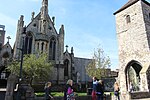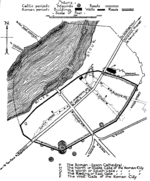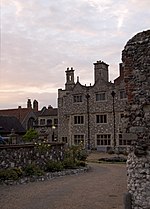Tomb of Edward, the Black Prince

The tomb of Edward, the Black Prince, was built in the 14th century for Edward of Woodstock (d. 1376). He was the son of Edward III of England and heir apparent to the English throne until his early death from dysentery, aged 45. Due to his role in the Hundred Years' War and his characteristic black plate armour, Edward became known to history as "the Black Prince". Aware that he was dying and mindful of his legacy, his will (signed the day before he died) specified his desired place of burial, and contained detailed stipulations as to the design of his tomb and that it be located in the Trinity Chapel of Canterbury Cathedral, in Kent, England, where his body is still interred. The tomb consists of a recumbent tomb effigy, a tomb chest and a tester holding his heraldic achievements. Due to its highly detailed armour, the effigy is considered one of the most important examples of English medieval funerary art given that so few examples of contemporary armour survive. According to Jessica Barker of the Courtauld Institute of Art, "there is something deeply affecting about the way his armor is depicted on the tomb ... This isn't just any armor—it is his armor...replicated with complete fidelity even down to tiny details like the position of rivets."
Excerpt from the Wikipedia article Tomb of Edward, the Black Prince (License: CC BY-SA 3.0, Authors, Images).Tomb of Edward, the Black Prince
The Precincts, Canterbury The King's Mile
Geographical coordinates (GPS) Address Website Nearby Places Show on map
Geographical coordinates (GPS)
| Latitude | Longitude |
|---|---|
| N 51.27965 ° | E 1.08366 ° |
Address
Canterbury Cathedral
The Precincts
CT1 2EG Canterbury, The King's Mile
England, United Kingdom
Open on Google Maps










